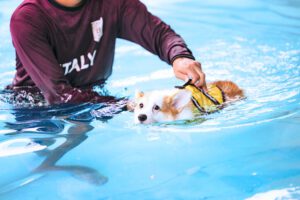Contrary to what many believe, dogs don’t naturally know how to swim. When dogs “dog paddle,” it’s more of a survival mechanism than a swim stroke, and it’s a very inefficient way to move through the water. Here’s how you can help your dog develop a smoother swim stroke:
- Practice safe swimming. Bodies of water pose numerous dangers to dogs: playing to the point of exhaustion or heat stroke, “water poisoning” (a frequently lethal condition that results from the body taking in more water than it can handle), or poisoning from toxic algae blooms are all possibilities when working around the water. Know where the nearest 24-hour emergency veterinary hospital is located – both near your home and when travelling. For more safety tips, see “Keep Your Dog Safe Around the Pool This Summer.”
- Fit your dog with a life jacket. A well-fitting life jacket can help your dog relax in the water when he realizes he’s not sinking. The added buoyancy also helps support heavily muscled breeds and can make it easier for older or less athletic dogs to maintain their limited endurance.
- Go slow. Not all dogs enjoy water and that’s OK. Never throw your dog in the water thinking he’ll figure it out. If you’re working around a pool, take time to build a positive association with the steps – where your dog will safely exit – so he knows how to get out. Feeding treats or offering a toy on the top step helps. You can also build your dog’s confidence by taking him to a natural body of calm water and letting him wade at his own pace.
- Practice an effective swim stroke. Work in calm water where you can safely and comfortably stand. Once your dog is comfortable around the water, on the top step or wading in so long as there’s land below, carry him in and lower yourselves into the water. Using the handle on his life jacket or a hand gently supporting his midsection from below, point your dog toward the exit point and let him go once he’s relatively relaxed.
- Don’t overdo it. Swimming is not only a good workout, learning to swim is a mental workout. Keep sessions short and positive and give your dog plenty of time to rest after a swim session.






